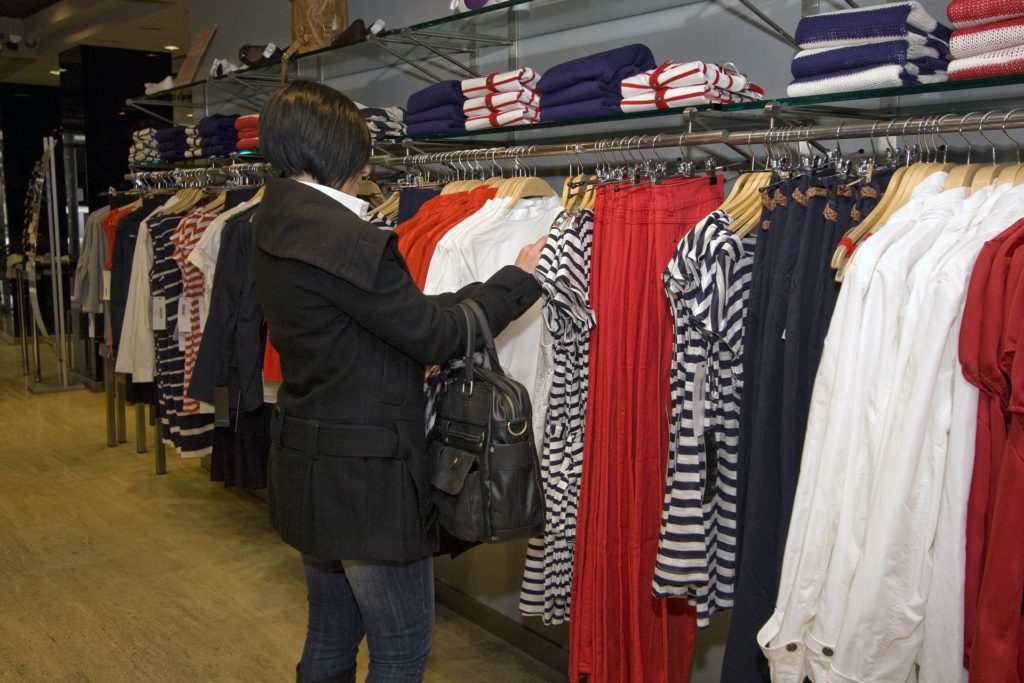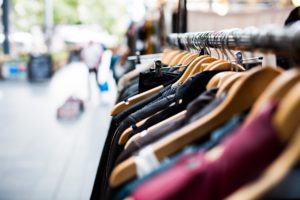- Calls to this hotline are currently being directed to Within Health, Fay or Eating Disorder Solutions
- Representatives are standing by 24/7 to help answer your questions
- All calls are confidential and HIPAA compliant
- There is no obligation or cost to call
- Eating Disorder Hope does not receive any commissions or fees dependent upon which provider you select
- Additional treatment providers are located on our directory or samhsa.gov
Clothes Shopping Struggles: Building a Recovery-Focused Wardrobe

Contributor: Elizabeth Haldeman, MS, OTR/L is the Occupational Therapy (OT) Coordinator at The Center for Eating Disorders at Sheppard Pratt
What do a person’s clothes have to do with eating disorder recovery? Much more than many people realize.
Eating disorders are frequently accompanied by negative body image, including general body dissatisfaction, body image distortions, overvaluation of weight and shape, excessive body comparisons and body checking behaviors. All of these can make dressing oneself and shopping for clothes quite overwhelming and anxiety provoking. A cultural emphasis on clothing sizes and marketing of unrealistic body types can make it even harder.
Furthermore, it is fairly common for a person’s body to change in size or shape as he or she heals and recovers from an eating disorder. As a result, someone may be left with a myriad of clothing that no longer fits – often referred to as “sick clothes.”
Sick clothes can be items that do not currently fit, only fit when the person is ill or actively engaging in eating disorder symptoms, or too-small/too-big clothing that is kept under the assumption that it might fit again someday in the future. Most therapists recommend permanently removing sick clothes from your closet by donating them, throwing them away, or in some cases repurposing them as rags or crafts.
Once someone is able to get rid of their sick clothes, it is important for that person to replenish the missing pieces with clothing items that fit their recovered body. This raises new challenges, given that clothes shopping and trying on new clothing is often a source of anxiety and frustration for people with body dissatisfaction.
Nonetheless, shopping for clothes is generally part of a normal life experience and building a wardrobe that is conducive to recovery is essential for healing.
What is a Recovery-Focused Wardrobe?
A recovery-focused wardrobe includes clothing that properly fits your body at a stable, healthy weight and is neither too small (pinching/excessively tight) or too big (in an attempt to hide or avoid your body).
 It may sound trivial, but ensuring you have a closet full of comfortable and appropriate clothing can be a form of relapse prevention in and of itself.
It may sound trivial, but ensuring you have a closet full of comfortable and appropriate clothing can be a form of relapse prevention in and of itself.
As an occupational therapist, my role includes accompanying patients on experiential shopping trips designed to help them practice new skills and manage anxiety related to the clothes-shopping task.
The following are some strategies we use to help adolescents and adults complete successful shopping trips during treatment. They can be utilized at any point in the recovery process to encourage healthy shopping behaviors and improve overall body image.
1. Shop for one item at a time. With a therapist or support person, have a conversation in advance to determine a particular article of clothing you would like to purchase. Many times, this is dictated by need and based on what you’ve gotten rid of and need to replace. Decide on a store, item, style and price range before you leave. This reduces the chances of becoming overwhelmed and can keep you focused on one manageable goal at a time.
2. Bring a support person if possible. If you know that your own self-assessment is still significantly distorted, then shopping with a trusted family member or friend is preferable. On initial trips during the early stages of recovery, it is best if your support person not shop for their own clothes. This will keep the trip from becoming too long and lessen the opportunity for body image comparisons.
3. Start with style and color. If you are shopping for jeans, for example, start by choosing a style (bootcut, relaxed, cropped/ankle, etc.) and the color (dark, distressed, black) you like best. Gather that item in a range of three to four sizes, or ask your support person to collect them for you. After entering the dressing room, ask your support person to hand you the largest size first. Then, put it on without paying attention to the tag or size if you can. As you try each pair on, assess how it feels, not how it looks.
4. Focus on functionality and use concrete objectives. The goal is to add an article of clothing that provides you with a functional fit, allowing you to wear the item while engaging in daily life. It may take some practice initially through trial and error. For pants, this assessment might go something like this:
Were you able to pull them on and fasten them with ease?
Stand up straight. Are they the proper length?
When you sit down do they gap in the back, or fold too tightly into your abdomen?
Can you easily and comfortably cross your legs?
Bend over as if you needed to pick something up. Do the pants slide down or expose your undergarments?
Using strategic and functional tests like these help you keep the focus on proper fit while keeping body image distortions and appearance-based assessments out of the dressing room as much as possible.
5. Don’t just rely on the mirror. It’s a good idea to face away from the mirror while trying on clothes to avoid body checking. If you have a support person with you, encourage him or her in advance to replace visual feedback such as “that looks good” with prompts like “can you move around comfortably?,” or “do you like how that material feels?”
6. Ultimately, use comfort as a guide. When clothes are too tight, they act as a trigger for ED thoughts each time you wear them. Your distorted thoughts will tell you there is something wrong with your body when in reality the article of clothing may be poorly designed or is simply the wrong size. Choose an item that feels comfortable to you, lets you breathe without feeling constricted, and does not pinch or poke you in any way.
In addition to being practical and reducing triggers, this recovery-focused method of choosing will also build self-esteem, because it is a choice that says, “I deserve to feel comfortable.”
 7. Remember the truth about clothing sizes. If you do end up fixating on the size of an item you’re trying on, remind yourself that that there is no known law requiring clothing makers to adhere to specific size standards or measurements. In other words, a size 4 in one brand could be more closely matching a size 8 in a different brand. Even within the same clothing brand, you may fit in drastically different sizes depending on the style of the item you are buying.
7. Remember the truth about clothing sizes. If you do end up fixating on the size of an item you’re trying on, remind yourself that that there is no known law requiring clothing makers to adhere to specific size standards or measurements. In other words, a size 4 in one brand could be more closely matching a size 8 in a different brand. Even within the same clothing brand, you may fit in drastically different sizes depending on the style of the item you are buying.
8. Take your coping skills “toolbox” and use what you have learned in treatment. Utilize cognitive behavioral therapy (CBT) skills to challenge distorted thoughts about your body. Practice deep breathing and mindfulness when things get overwhelming. Try to stay in the moment without judging yourself. After all, clothes are meant to fit the person, not the other way around.
About the author:
 Elizabeth Haldeman, MS, OTR/L is the Occupational Therapy (OT) Coordinator at The Center for Eating Disorders at Sheppard Pratt in Baltimore, Maryland. For the past 6 years she has worked with adults and adolescents recovering from eating disorders, individually and in group settings, to help increase functional life skills through engagement in occupation. As Coordinator she oversees all OT staff in their work with patients throughout The Center’s inpatient, partial hospital and intensive outpatient programs.
Elizabeth Haldeman, MS, OTR/L is the Occupational Therapy (OT) Coordinator at The Center for Eating Disorders at Sheppard Pratt in Baltimore, Maryland. For the past 6 years she has worked with adults and adolescents recovering from eating disorders, individually and in group settings, to help increase functional life skills through engagement in occupation. As Coordinator she oversees all OT staff in their work with patients throughout The Center’s inpatient, partial hospital and intensive outpatient programs.
The opinions and views of our guest contributors are shared to provide a broad perspective of eating disorders. These are not necessarily the views of Eating Disorder Hope, but an effort to offer discussion of various issues by different concerned individuals.
We at Eating Disorder Hope understand that eating disorders result from a combination of environmental and genetic factors. If you or a loved one are suffering from an eating disorder, please know that there is hope for you, and seek immediate professional help.
Published May 24, 2017.
Reviewed By: Jacquelyn Ekern, MS, LPC on May 23, 2017
Published on EatingDisorderHope.com

The EatingDisorderHope.com editorial team comprises experienced writers, editors, and medical reviewers specializing in eating disorders, treatment, and mental and behavioral health.

